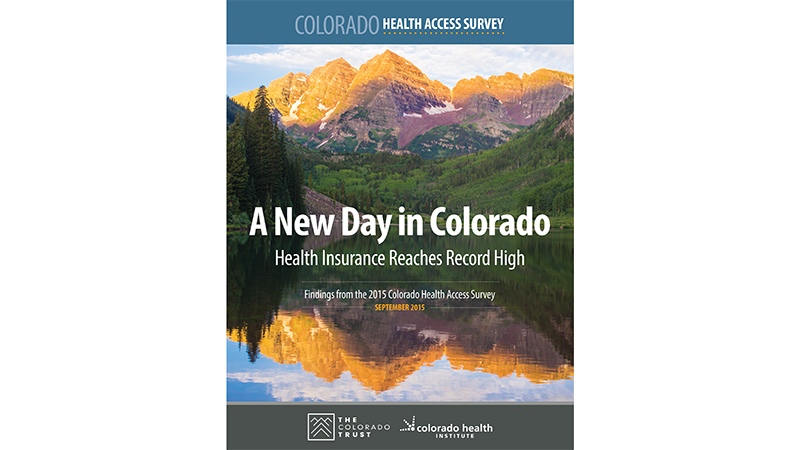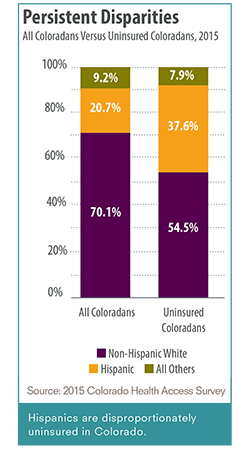Coverage Leaps, But Disparities Stick
Leer en español
Findings from the 2015 Colorado Health Access Survey.
 An astounding 93 percent of Coloradans had health insurance in 2015, according to the latest count by the Colorado Health Access Survey, up from 86 percent in 2013. The biennial tally, released in September, provided the best look yet at how well policies to expand Medicaid and private insurance are working in our state.
An astounding 93 percent of Coloradans had health insurance in 2015, according to the latest count by the Colorado Health Access Survey, up from 86 percent in 2013. The biennial tally, released in September, provided the best look yet at how well policies to expand Medicaid and private insurance are working in our state.
“Colorado is a state that has done what it set out to do, and that is to get more people insured,” said Michele Lueck, president and chief executive of the Colorado Health Institute (CHI), which administers the survey with funding from The Colorado Trust.
At the same time, the survey highlighted continuing disparities statewide across income, race and geographic lines in regards to the number of people insured, the affordability of health care and the overall health of Coloradans.
The survey found that Western Slope residents were much less likely to be insured than those living in the Front Range. And according to a statistical model that CHI devised to estimate uninsurance by zip code using survey data, people living in the Eastern Plains town of Limon had a nearly 20 percent probability of being uninsured, compared with Jefferson County zip codes where the probability of being uninsured was just 1.3 percent.
Latinos in the state remained the most likely to be without insurance, representing nearly 38 percent of those without insurance but only 21 percent of the overall population. They include undocumented immigrants, who are barred under the law from obtaining public insurance or subsidized private health plans.
The overall leap in the number of insured Coloradans, including 450,000 more people enrolled in Medicaid, marked huge progress.
“There are many more people receiving primary care services, and this is a wonderful positive,” says Gisela Garrison, director of Northwest Colorado Health, a Trust grantee that provides nursing, home health and other services in Moffat and Routt counties.
But the gains obscured continued problems with affordability for many. Around 10 percent of Coloradans said they didn’t see a doctor because of cost in 2015, down from 12 percent in 2013.
The number of those who are underinsured (spending more than 10 percent of one’s income on health care) has actually increased since 2013, the survey revealed. Around 16 percent of Coloradans are now underinsured, up from 14 percent in 2013. About one in four of the Coloradans who bought insurance on the individual market are underinsured.
Across the state, advances in coverage have also so far left intact the state’s deep health disparities, according to the survey.
Lower-income Coloradans were more than twice as likely to report physical health problems as those in the highest income bracket. They were three times as likely to have mental health or oral health problems.
More than one in five black Coloradans report having dental problems. That’s compared to just 13 percent of whites and 14 percent of Hispanics.
And one in five Hispanic Coloradans reported having physical health problems, compared with 11 percent of whites.
In the San Luis Valley, more than one in four residents who responded to the survey said they were in fair or poor physical health—the worst rate in the state.
“Poverty, education, child care, geography—those are all pieces of the larger puzzle,” says Brooke Powers, program and policy manager for ClinicNet, a Trust grantee that advocates for safetynet health services. “Coverage is a piece of it.”